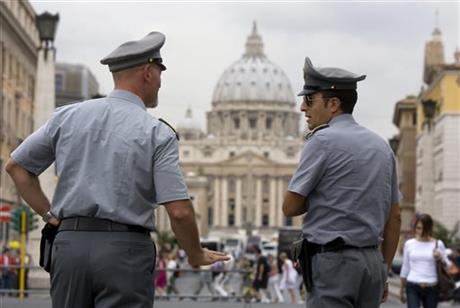
By NICOLE WINFIELD
FILE – In this Tuesday, Sept. 21, 2010, file photo, Italian financial police officers talk to each other in front of St. Peter’s Square at the Vatican. The Vatican took another step in its efforts to be more financially transparent by publishing a first-ever annual report for the Vatican bank on Tuesday, Oct. 1, 2013. It comes as Italian prosecutors investigate alleged money-laundering there, a Vatican monsignor remains in detention and the pope himself probes the problems that have brought such scandal to the institution. (AP Photo/Angelo Carconi, File)
VATICAN CITY (AP) — The Vatican took another step in its efforts to be more financially transparent by publishing a first-ever annual report for the Vatican bank on Tuesday. It comes as Italian prosecutors investigate alleged money-laundering there, a Vatican monsignor remains in detention and the pope himself probes the problems that have brought such scandal to the institution.
Net earnings at the bank, known as the Institute for Religious Works, rose more than four-fold to 86.6 million euros ($116.95 million) in 2012, the report said. More than 50 million euros of that was given to the pope for his charitable works.
The improvement in earnings was driven by profits made on the value of securities that the bank held and sold — net trading income rose to 51.1 million euros from a loss of 38.2 million euros in 2011.
The picture may not be so rosy for 2013, with rising interest rates cutting into profits and millions of euros earmarked for the IOR’s ongoing transparency process, which has involved hiring outside legal, financial and communications experts to revamp its procedures, review its client base and remake its image.
“Overall, we expect 2013 to be marked by the extraordinary expenses for the ongoing reform and remediation process, and the effects of rising interest rates,” bank president Ernst von Freyberg said in a statement.
He said the publication of the report meets the bank’s commitment to providing transparency about its activities.
Aside from the earnings, the 100-page report published Tuesday provides some fascinating reading about the secretive institution: The IOR in 2012 had 41.3 million euros in gold, metals and precious coins, owned a real estate company and was bequeathed two investment properties worth 1.9 million euros. It also made some 25.8 million euros in loans in 2012.
The Vatican has long insisted the IOR isn’t a bank but a unique financial institution aimed at managing assets for religious or charitable works — a distinction that presumably helped it avoid typical banking regulations. Yet in the past year, the IOR has slowly revealed itself to work very much like a bank, providing asset management services to its clients, earning some 12.2 million euros in fees and commissions for such services in 2012 and making loans.
The Vatican is about to enter a second round of international scrutiny by the Council of Europe’s Moneyval committee, which helps countries comply with international norms to fight money laundering and terrorist financing. The Vatican passed Moneyval’s inaugural inspection last year, but evaluators gave the IOR and the Vatican’s financial oversight agency poor or failing grades for insufficient controls to ensure that its clients and assets were clean.
The report was released as Rome prosecutors continue to investigate a Vatican accountant, Monsignor Nunzio Scarano, who was arrested in an alleged plot to bring 20 million euros into Italy from Switzerland without declaring it at customs. Scarano is also under investigation in his native Salerno for allegedly laundering money through his IOR account. His lawyer has insisted the money was clean and that he was only trying to help out friends.
The IOR’s former top managers, Paolo Cipriani and Massimo Tulli, meanwhile, are under investigation by Rome prosecutors for alleged violations of Italy’s anti-money laundering norms. Rome financial police launched the investigation in 2010, seizing 23 million euros ($30 million) from a Vatican account at an Italian bank after determining that the IOR hadn’t provided sufficient information about the transaction. The Vatican has said it was a misunderstanding and money was eventually ordered released.
Cipriani and Tulli resigned in July.
Around the same time, Pope Francis created a commission of inquiry into the IOR to look into every aspect of its operations to get to the bottom of the scandals that have bedeviled it. The commission has wide-ranging authority to obtain documents, data and information, even overriding traditional banking secrecy rules to get it. Francis also named a trusted prelate to be his eyes inside the bank to figure out what really goes on inside the tower just inside the Vatican walls.
The Vatican bank was founded in 1942 by Pope Pius XII. It employs 114 people, runs the Vatican pension system and oversees about 6.3 billion euros in customer assets. Its customer base has been reduced from some 21,000 customers in 2011 to 18,900 last year, thanks to efforts to close inactive accounts. Customers include religious orders; Vatican offices, embassies and employees; individual cardinals, bishops and priests and foreign embassies accredited to the Holy See.
___



